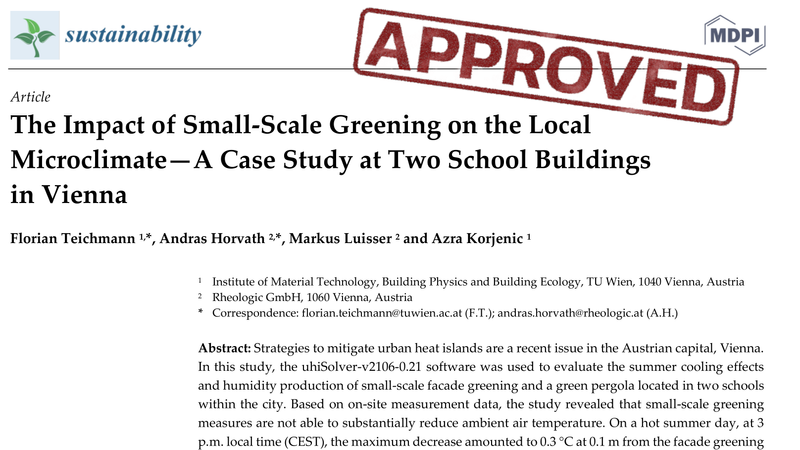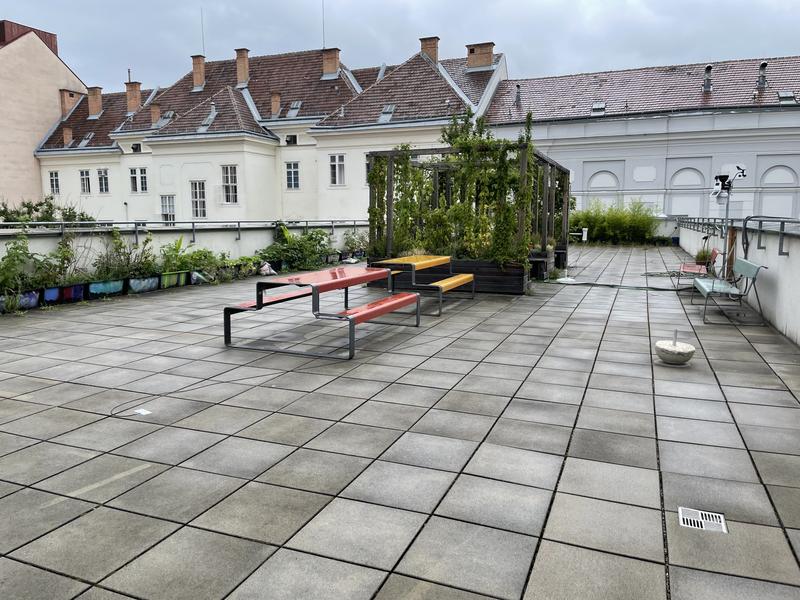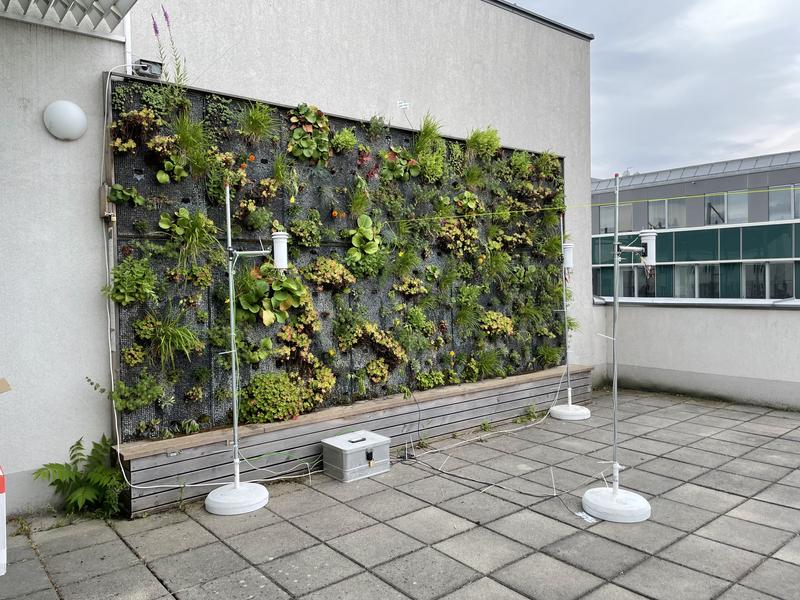The Impact of Small Scale Urban Greening on Air Temperature

As engineers and scientists we know that it is crucial to back up one’s work with irrefutable measurements. As marketeers and managers we experience bold claims of market participants, with little to no backing and validation. As team and enterprise we consciously walk a different path and do our best to validate our models, to earn the trust of our customers. The gold standard for validation is and remains publication of scientific papers under the scrutiny of the scientific community. We are proud to announce the publication of our latest scientific paper: The Impact of Small-Scale Greening on the Local Microclimate.
You can download the full, peer-reviewed paper of this measurement/validation campaign at the link below. It’s open access!
For this article we conducted long-term measurements in collaboration with the department of building physics from the Vienna University of Technology in the vicinity of small urban green walls and a pergola. Our goal was to validate our simulation models with respect to air temperature prediction. We also measured radiation intensity and moisture to assess the Apparent Temperature1 which indicates sojourn quality and how well the human body can keep its core temperature (this implies health and mortality impacts during urban heat waves).
In previous articles on our website we discussed urban surface temperatures of green and impervious surfaces and how fast air temperature can change over hot, dry surfaces, but how about green surfaces in the city?
In these previous articles we’ve already mentioned - although without quantification -, that turbulence, roughness2 and wind velocity play a crucial role in how surface temperature is transferred into air temperature. Another factor is also the size of cooler surfaces - the bigger, the more influence. But how does actual green architecture perform in real urban settings?
Leaf temperature Most people would say that leaves are cool, however, this is deceiving. First, we compare leaf temperature to our own body temperature, which at 37°C is a relatively high temperature for air. Second we often perceive leaves in the vicinity of trees - however the feeling of coolness is due to the trees blocking solar radiation, rather than any change in air temperature (see our article about human thermoregulation).
Leaves can be cooler or warmer than the surrounding air depending on wind velocity, turbulence, evaporation rate, plant type and solar radiation. They will often have a surface temperature from 5°C lower to 15°C higher than the air temperature. Many plants can survive leaf temperatures of more than 45°C and some even 55°C.
For details, see this excellent article about Transpiration and Leaf Temperature in particular leaf temperatures in a hot and dry environment (like during a heat wave in a city) by the University of Washington Center for Quantitative Science. Another, more visual guide, is this page about leaf surface temperature by a growing light manufacturer, which confirms that leaves under intense radiation, like on a cloudless summer day, are hotter than the surrounding air in many cases.
The results of our research show that small scale green architecture like single pergolas or green walls, have little impact on the air temperature. Much larger green surfaces - think parks - with sufficient water supply are needed to cool the air vs. warmer air over impervious urban surfaces. Under the measurement conditions we found a maximum cooling effect of 0.3°C inside respectively directly next to the green infrastructure.
However, the apparent temperature1, which describes the temperature relevant for human sojourn quality and health, was up to 4 degrees cooler for the pergola, which is quite a significant improvement for a relatively small green infrastructure. This improvement was largely an effect of the shading and not due to any significant reduction in air temperature.


It is by no means our intent to discourage small-scale urban greening projects. On the contrary! As the pergola example shows, green infrastructure is well capable of improving the sojourn quality and health implications of urban heat waves, by a whopping 4°C. Smart planning, with the best available tools and favouring apparent temperature over air temperature can have significant beneficial effects for quality of living in the built environment with all the implications of health effects during heat waves and emphasizes the role of high-quality urban landscaping for placemaking and design of human-accessible spaces in cities.
However the impact of such green structures on air temperature is negligible in the size and under conditions we observed. Much larger areas are needed to influence air temperature in a significant way - parks and similar green/blue, recreational areas play a crucial role in this respect. This is consistent with other published work3, finding that an urban park of moderate size in Singapore is capable of an air temperature reduction of around 1°C. The authors point out - as we have done in various articles - that without sufficient water supply which enables evapotranspiration or other factors that inhibit this cooling mechanism (e.g. low wind velocity), the temperature may also rise within the tree canopy. Likewise the study finds, that shading is the main governing mechanism for improved thermal comfort under these circumstances. Like we at Rheologic, the researchers from the ETH Zurich (Future Cities Laboratory) and the National University of Singapore come to the same conclusion and argue to favour shade (=trees with wide crowns) over other factors to improve health effects and sojourn quality in hot urban conditions.
The measurements of the experts of the Department of Building Physics of the Vienna University of Technology also demonstrate the high accuracy with which our models can resolve such small-scale effects even in the complex 3-dimensional environment that cities present. Despite some lingering questions about the radiation influence on temperature measurements, simulated and measured trends are in agreement with respect to air temperature (standard deviation of only around 1°C!) and all other major impact factors like surface temperature and humidity. We will also build upon this research to keep developing our algorithms for even more accurate radiation modelling, due to its importance for human physiology.
Acknowledgments: This research was supported by the Austrian Research Promotion Agency (FFG) as well as by the Climate and Energy Fund of the Federal Ministry for Climate Action, Environment, Energy, Mobility, Innovation and Technology (BMK) within the framework of the Smart Cities Demo—Boosting Urban Innovation funding line. Open Access Funding by TU Wien.
Apparent Temperature, also called felt or physiological temperature, includes the effect of air temperature, humidity, solar radiation and wind velocity and is the Australian standard for hot weather warnings reported in the form of a Heat Index Temperature ↩ ↩2
With respect to meteorology and microclimate in cities, roughness is a term describing how much turbulence is introduced into an air flow by an uneven surface. This is the same principle that lets water flow without turbulence over a smooth surface, but causes it to become turbulent when flowing over rough pebbles for example. In meteorology an entire city has a roughness, for our microclimate simulations, grass surfaces, green walls, buildings etc. have a roughness. ↩
see https://doi.org/10.1016/j.uclim.2021.100939 for the open-access paper. ↩
Published: